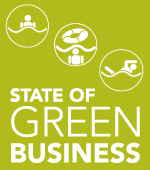Growing the Cloud, Greening the Planet
<p>Microsoft's Rob Bernard offers a look at what our wholesale migration to cloud-based services means for how we operate, how we interact, and how we do sustainability.</p>

Readers of this website may be more in-tune about what "The Cloud" is than the masses -- although maybe a couple dozen raised their hand in recognition, out of several hundred attendees at the State of Green Business Forum this morning -- the odds are about 100 percent that you're intimately connected to The Cloud.
Cloud computing, the distribution of IT services to remote data centers -- think webmail, YouTube, Twitter, and so on -- has become ubiquitous in recent years, and it's only going to expand in prominence.
It's also become the focus of Microsoft's strategies, both for technological advancement and for environmental sustainability. And the company is investing heavily in developing and spreading the power of the cloud.
"These are underlying societal trends, in which massive amounts of data and applications are built on platforms, and those platforms need to change," explained Rob Bernard, the Chief Environmental Strategist at Microsoft.
Those platforms are everything from university research on climate models -- currently running most climate models take about a month to complete, but Microsoft is working to bring that down to days or even hours -- to home and building energy management.
Energy management illustrates some of the challenges posed by building sustainability into technology whether through the cloud or anywhere. Thinking about the evolution from manually programming your VCR to training your DVR to record your favorite TV shows highlights what needs to happen with energy controls.
Bernard said the solution is to "make it invisible."
"You can run around turning down thermostats, but you really want it to happen automatically," he explained. "The thing I always talk about is why it is that my phone knows I'm standing on this stage, but my office doesn't, and my home doesn't, and even the hotel room I just left doesn't."
In order to speed the adoption of things like smart building controls, Microsoft partners with a number of companies, including Johnson Controls, with the goal of making those technologies both commonplace and invisible.
In order to do that, though, Microsoft and the rest of the world will need a lot more data centers. Bernard showcased Microsoft's "data center of the future" -- a highly efficient computing center that isn't built within concrete walls, and which can be dragged-and-dropped into wherever its needed, allowing for rapid scaling of cloud technologies.
With the technology developed to bring cloud computing everywhere, what can individuals and companies do with it?
Bernard talked about the winner of Microsoft's Imagine Cup from two years ago. A group of students in Australia developed a sensor network that mashed together with maps and weather information to help smartly control the water used on a farm, as well as picking the ideal time to harvest crops. The project managed to cut water use on the farm by 50 percent.
"These are the kinds of transformations we need everywhere in society," Bernard said. Other areas that Microsoft is focusing on include charging electric vehicles in a way that won't collapse the electric grid, and developing new tools for scientists to further environmental innovation.
Bernard's presentation shined a spotlight on, just as IT has evolved to become part of the fabric of everyday life, it is also quickly become part of the fabric of every kind of green activity.
A clip from Bernard's presentation is below, and the full video is available online from GreenBiz.com.
Photo by Goodwin Ogbuehi, http://flickr.com/photos/yoshikatsu.






